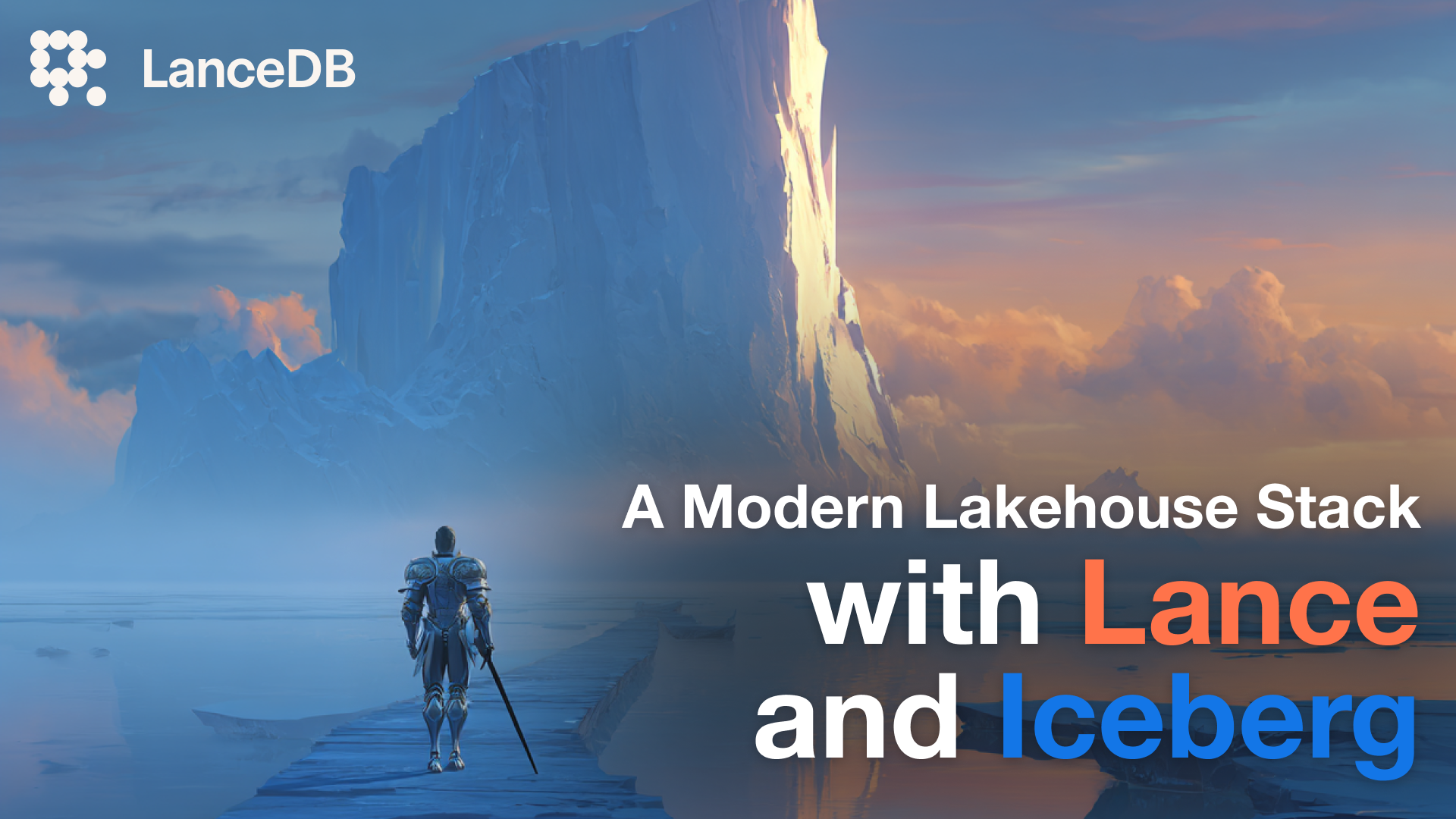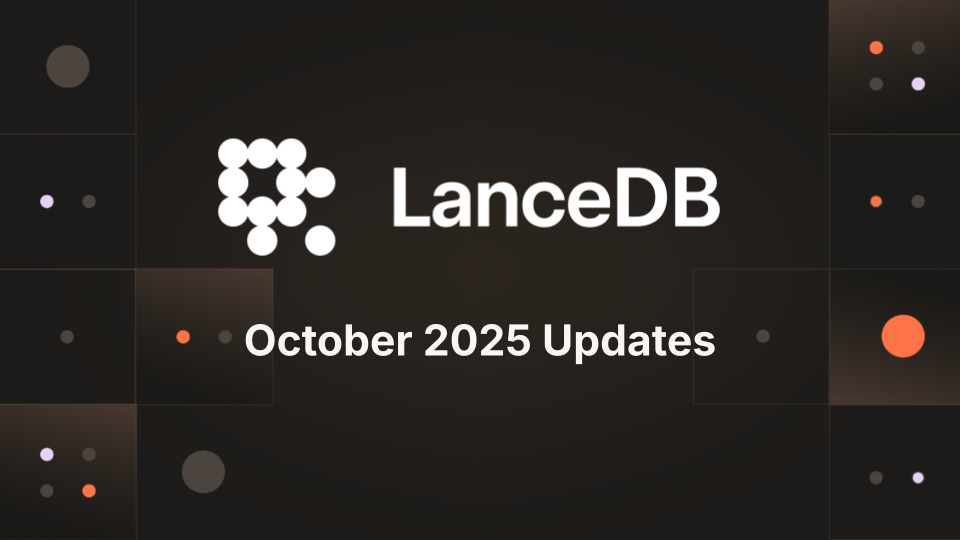The modern, composable data stack has evolved around the idea of the lakehouse — a unified system that blends the flexibility of data lakes (i.e., object stores designed to hold data in open file formats) with the analytical performance and reliability of data warehouses. Projects like Apache Iceberg have been pivotal in making this vision a reality, offering transactional guarantees and schema evolution at scale.
But as AI and machine learning workloads bring with them ever larger amounts of data from multiple modalities (e.g., text, images, audio, video, sensor data), newer formats like Lance are emerging to take the next leap forward. Lance is a high-performance columnar format that’s purpose-built for AI/ML workloads (training, feature engineering) and multimodal data at petabyte scale.
The goal of this post is to explain where Iceberg and Lance fit in the modern lakehouse stack, while discussing some of their key differences. We’ll highlight emerging data architectures that are bridging the worlds of analytics and AI/ML workloads using these two formats, all built on the same data foundation.
Understanding the modern lakehouse stack
The modern lakehouse architecture consists of six distinct technological layers, each serving a specific purpose. Let’s dissect these layers (from the bottom up) to understand where Lance and Iceberg fit in, and how they can work together.
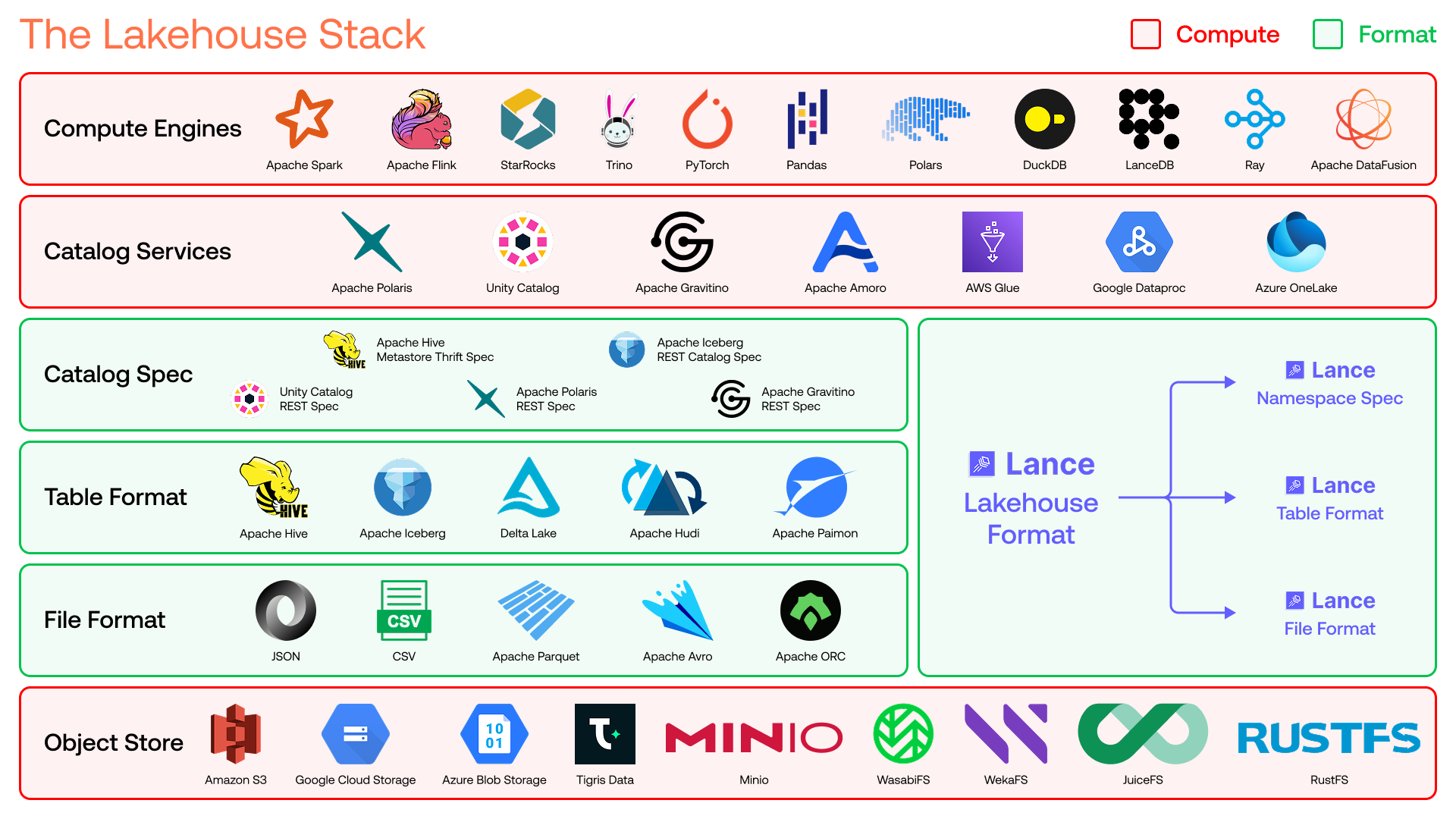
Object store
At the foundation of the lakehouse lies the object store — these are storage systems characterized by their simple, object-based hierarchy, typically providing high durability guarantees with HTTP-based communication for data transfer.
File format
The file format describes how a single file should be stored on disk. This is where formats like Lance, Parquet, ORC, and Avro are present. The file format defines the internal structure, encoding, and compression of individual data files.
Table format
The table format describes how multiple files work together to form a logical table. Table formats must include features like transactional commits and read isolation, so that multiple writers and readers can safely operate against the same table.
Catalog spec
The catalog spec defines how any system can discover and manage a collection of tables within storage. It acts as the bridge between the storage layer and the compute layer of the stack (starting with the catalog service, more on this below).
Catalog service
A catalog service offers easy connectivity to the compute engines on top, and implements one or more catalog specs to provide both table metadata and, optionally, continuous background maintenance (compaction, optimization, index updates) that table formats require to stay performant.
Compute engine
The compute engine is the workhorse built on top of catalog services that leverage their awareness of catalog specs, table formats and file formats to perform complex data workflows. Compute engines are carefully designed to handle a variety of workloads, including SQL queries, analytics processing, vector search, full-text search, machine learning training.
Differences between Lance and Iceberg
The key insight from the lakehouse architecture described above is that the file format, table format, and catalog spec layers are just storage specifications. Compute power resides only in the object store, catalog services, and compute engine layers. This clear separation of concerns is what allows lakehouse storage to be flexible, portable, and independently scalable, while opening up the same underlying data for discovery by any catalog service, and for processing by any compatible compute engine.
Iceberg operates at two of the layers in the stack: the table format and the catalog spec. It typically uses Parquet as the underlying file format.
Lance spans three layers of the stack, because it’s simultaneously a file format, table format and a catalog spec.

In the sections below, we’ll compare and contrast Lance and Iceberg at each of these layers.
Table format
Iceberg employs a three-level metadata hierarchy in its table format: a table metadata file → manifest list → manifest files. The table metadata (a JSON file) rolls up a comprehensive history of past commits and schemas, and stores the partition specs, snapshot references and table properties. Each snapshot points to a manifest list (Avro) that contains metadata about manifest files and partition statistics (also Avro), and the manifests contain lists of data files that sit in the object store. Note that the Iceberg table format itself does not define how to atomically commit data — instead, it just describes the latest table metadata location, and it’s left to the catalog service to determine how to actually do the commit.
Lance employs a single-level metadata hierarchy, with one manifest file per table version. Lance tables use the notion of fragments, rather than partitions. Each commit to a Lance table produces a new manifest file that contains fragments (each with their own data and deletion files) and pointers to the index files (for FTS, vector and other scalar indexes).
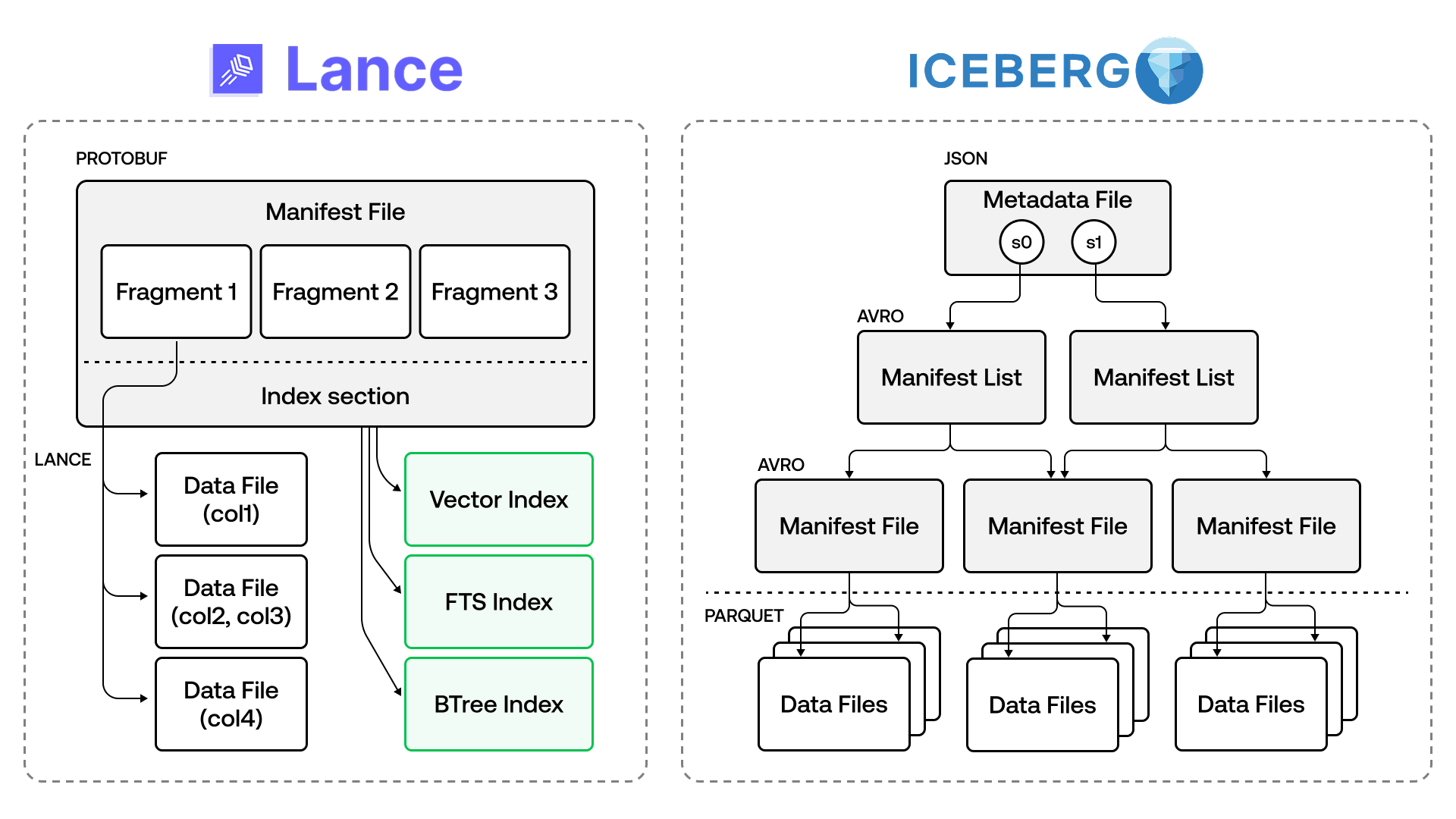
File format
Iceberg supports multiple file formats under the hood. Parquet is the most prevalent and widely used, but Avro and ORC formats are also supported.
From a file format perspective, Lance does away with row groups (unlike Parquet, which heavily relies on them), achieving a high degree of parallelism, achieving 100x the random access performance of Parquet without sacrificing scan performance. There are several other differences between Lance and Parquet that won’t be discussed here, but you can read more about it in this VLDB 2025 paper: Efficient Random Access in Columnar Storage through Adaptive Structural Encodings .
Catalog spec
Because of the way Iceberg delegates the actual atomic write guarantees to arbitrary catalog services, over the years there have been many protocols developed by the vendors building these catalog services. Iceberg’s “REST Catalog spec” was developed as a wrapper to standardize these different protocols, and any catalog service adopting the spec is required to guarantee the atomicity of the API operation.
Lance uses “namespaces”, rather than explicitly defining a catalog spec. In fact, Lance intentionally names it “Lance Namespace” rather than “Lance Catalog”, because it’s a thin wrapper to allow storing and managing a Lance table via any catalog service, and is not aimed to be a complete catalog spec. In the future, to provide a full catalog spec experience, Lance aims to use Arrow Flight gRPC as its main standard, to be compatible with Lance’s vision of being an “Arrow-native lakehouse format”.
When Lance is beneficial
In this section, we’ll list the key benefits of using Lance over Iceberg, especially for AI/ML workloads.
Fast random access for search, ML, and AI
Earlier generations of open table formats (Iceberg, Delta Lake and Hudi) were primarily designed as replacements for Hive. They focus mainly on data warehouse (OLAP) workloads, with tables that are typically “long but narrow”.
Lance, on the other hand, is designed from the ground up to support machine learning and AI workloads, with fundamentally different access patterns and upport for tables that are “ long and wide ” (e.g., embeddings, blobs and deeply nested data in columns). Lance can index billions of vectors in hours , storing tens of petabytes of data. For vector search, it can support more than 10,000 QPS with <50 ms latency over object storage. For ML training, Lance integrates with PyTorch and JAX data loaders, achieving (through a distributed cache fleet) more than 5 million IOPS from NVMe SSDs.
Combining fast random access with native indexes within the same format is what gives Lance a significant advantage in ML and AI use cases, compared to scan-based approaches that are common in traditional lakehouses relying on Iceberg.
Multimodal data done right
Multimodal data (images, videos, audio, deeply nested point clouds and their associated embeddings) is becoming more and more common, especially in the age of AI, where it’s never been easier to generate and consume huge amounts of data.
In many Iceberg deployments today, multimodal data is modeled as columns in tables (like any other tabular data), with pointers to the actual data located in object storage. This isn’t ideal from a data governance perspective, because organizations would need separate access control layers and extra operational plumbing across various systems. It’s also not ideal from a performance perspective, because there is additional I/O and network overhead while fetching individual data items.
Lance’s file format makes it more convenient to maintain multimodal data natively as blobs inside the columns, with no external lookups (the multimodal data is co-located with metadata and embeddings), thus simplifying governance and management of data that’s multimodal in nature. It’s also significantly more performant, because at the table level, Lance can pack multiple smaller rows together while storing very large rows (e.g., image or audio blobs) in a dedicated file thanks to its fragment-based design, thus balancing performance with storage size.
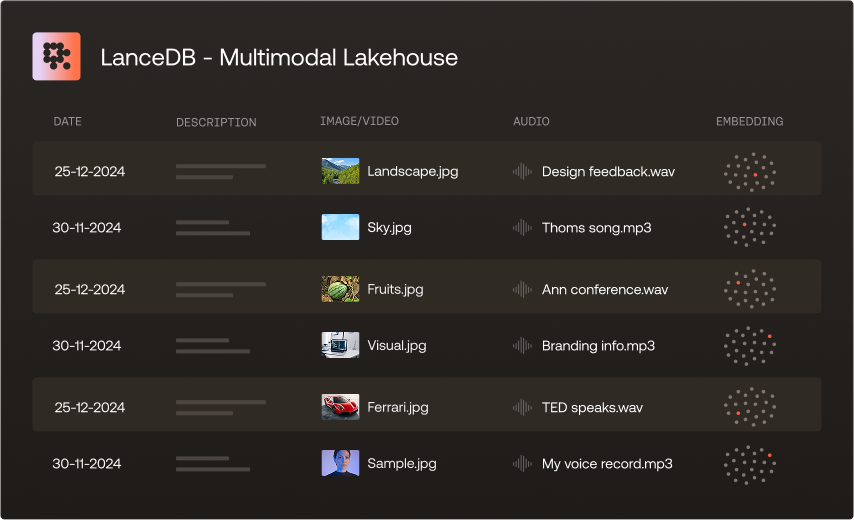
Flexible, zero-cost data evolution
A common need as the dataset scales in size is data evolution, i.e., changes to the table schema and adding, updating or removing columns and their associated data. These types of operations are especially common in ML/AI applications, where multiple developers working in parallel frequently add features, predictions or embeddings as new columns to an existing table. In Iceberg, data evolution comes with a non-trivial cost — adding data to a new column requires a full table rewrite since Parquet stores entire row groups together. This means that for very large tables, it’s common to see multiple new feature columns being added in parallel by multiple teams in an organization – which would require a table lock as new columns are being added, bottlenecking the feature engineering process.
In Lance, adding a new column is essentially a zero-copy operation. Lance’s fragment design allows independent column files per fragment (though multiple columns can share a data file), meaning that adding or updating a column simply appends new column files without touching existing data. This avoids duplication on petabytes of data, as noted by Netflix as they built out their media data lake incorporating LanceDB.

The space savings can be tremendous – say you have an existing table that’s 100 GB in size. If you update the table schema and add a new column that’s only 1% this size (1 GB) – in Iceberg, performing a backfill operation on the new column would require a full table copy amounting to 101 GB of writes. In LanceDB, it would just be 1 GB of writes. The larger the dataset, the more this matters. The ability to continuously or incrementally add features, without duplicating or rewriting unaffected data, makes Lance a compelling choice for teams working with petabytes of data.
When Iceberg is beneficial
Iceberg’s partition-based, catalog-centric approach can still be beneficial for traditional BI or analytics workloads, for the reasons listed below. In this section, we’ll highlight some of them, as well as how Lance aims to address them in future versions.
Optimized for analytical workloads
Iceberg’s hidden partitioning logic and its three-level metadata hierarchy enable efficient partition pruning for compute engines that are optimized for analytics workloads, where queries are naturally filtered on partition keys. Lance, in contrast, uses fragments (rather than partitions) as the organizational unit for data, so at present, the way Lance organizes data doesn’t fit well with traditional OLAP-style compute engines that are heavily optimized for partition-based scans.
Newer methods like liquid clustering (developed by Databricks) can, in the future, actively leverage Lance’s features, because they avoid hard-coded table layouts and adopt an adaptive clustering approach that’s optimized based on actual query patterns. However, partitioning is a concept that’s deeply baked into current-generation query engines, so until liquid clustering gains wider adoption in the ecosystem, Iceberg has several advantages for analytics workloads.
Mature ecosystem integration
Iceberg has years of battle-hardening from production usage and is well-integrated with a mature ecosystem, including integrations with several compute engines and catalog services. In contrast, Lance’s compute engine integrations are still emerging (primarily Spark and Ray at present), with many more upcoming and in their nascent stages. There is strong community interest in adding Lance support to popular compute engines that are part of the Iceberg ecosystem, including Flink, StarRocks, and Trino. Expect this space to evolve over time.
Centralized observability
Iceberg’s catalog-dependent design means the catalog is aware of all table operations, enabling centralized monitoring and powerful automated optimization triggers. It also enable an easy-to-maintain unified audit log across all tables, with coordinated data lineage tracking.
Lance tables, like Delta Lake, can be modified directly in storage without catalog awareness. This storage-first design gives Lance a portability advantage but complicates activity tracking — downstream operations must rely on pull-based polling or storage event notifications (S3 Events, GCS Pub/Sub) rather than semantic catalog events. Lance’s approach to address this is through its managed offering, LanceDB Enterprise (which has knowledge of all read/write traffic), but in the future, there could be ways to onboard all operations onto open observability frameworks like OpenTelemetry for easy tracking in any tool that supports it.
Takeaways from the comparison
The following table summarizes the reasons Lance is emerging as a new standard for multimodal data and AI workloads in the lakehouse.
| Feature | Lance | Iceberg |
|---|---|---|
| Metadata Structure | Single-level manifest per version | Three-level hierarchy (metadata → manifest list → manifest) |
| Metadata Growth | Independent versions, no rollup | Metadata files accumulate snapshot history |
| Data Organization | Fragments (horizontal slices), global clustering/sorting | Partition specs with hidden partitioning, clustering/sorting within partition |
| Row Address | 64-bit addresses (fragment_id + offset) | file path + position tuple |
| File Format | Lance file format | Parquet/ORC/Avro |
| Index Support | Vector and full-text index, plus a standardized framework for new scalar index specifications | Puffin for simple NDV sketch, deletion vector |
Parquet and Iceberg, developed independently (in their own time frames), have led to an explosion of connectors, integrations and innovations up and down the layers of the lakehouse stack. However, a lot of these predate the age of AI, where the kinds of workloads and user requirements involved are changing at a blazing pace.
Lance is relatively new, and so it has had the opportunity to build and iterate rapidly from the ground up while learning from the successes and existing pain points of Iceberg/Parquet. The design features of Lance, as can be seen in the table above, incorporate several proven patterns while introducing new paradigms that aim to address the unique requirements of AI/ML workloads. Lance users can seamlessly interoperate across the various ML and data processing frameworks, from Pandas and Polars, to PyTorch and beyond.
A unified data platform with Lance and Iceberg
Looking at the trade-offs involved when choosing between Lance and Iceberg, especially for analytics vs. ML/AI workloads, we’re seeing a dual-format strategy in which large organizations are beginning to adopt Lance. Companies like Netflix are now using Lance tables for their AI and multimodal workloads, alongside Iceberg, which has long been their primary table format for BI and analytics workloads.
The figure below envisions how a unified lakehouse platform built on top of Lance and Iceberg might look, as more organizations build out their lakehouses on top of modern infrastructure.

From an Iceberg perspective, leveraging the parts of the lakehouse stack that are optimized for large analytics-style workloads allows enterprises to benefit from mature compute engine and catalog integrations in the Iceberg ecosystem.
From a Lance perspective, leveraging the file-level benefits of Lance (faster random access, multimodal blob handling, Arrow-native integrations) and its table-level benefits (fragment design allowing zero-copy data evolution and a pluggable index framework) allows enterprises to rapidly move forward with their AI workloads and keep up with new paradigms. All of this, built on top of the same data foundation.
These emerging architectural patterns reflect a broader trend: managing the separate needs of analytics and AI workloads with two distinct but interoperable formats — Iceberg for BI, and Lance for AI and multimodal data, bridging the best of both worlds.

